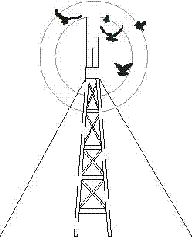-Presented by-
United States
Fish and
Wildlife Service




Wednesday, August 11, 1999
1:00- 5:45 pm
Cornell University's Statler Hotel
117th Meeting of the American
Ornithologists' Union
|
-Presented by- United States |
 |
|
 |
 |
 |
|
Though birdkills at lighthouses had been noted for centuries, it is
unlikely that anyone anticipated the often large number of songbirds that
would be killed at tall TV towers which were lighted at night for aviation
safety. People began documenting bird kills at tall communications towers
in North America during the late 1940s - such towers were then being
constructed on the continent to broadcast the emerging television medium.
As happens with lighthouses, on foggy or low cloud- ceiling nights,
migrating birds seem to be attracted to the lights on the towers, mill
about them for lack of stronger navigational cues, and became apparently
disoriented. Mortality at these towers was chiefly attributed to
collisions with the guy wires used to support the towers. Though tragic,
large kills appeared to be relatively rare, up to and including the 1980s
and 1990s, and there was little evidence that anyone thought songbirds
were declining as a result of collisions with towers - the birds seemed
abundant. Nonetheless, the kills were appalling to bird lovers and
towerkill studies began at a number of tall towers across the continent.
Most ornithologists and a small portion of the public became aware of the
periodic bird kills. A decline in the number of towerkill studies and
diminished attention to the issue occurred during the 1980s and 1990s.
Now, with the recent erection of thousands of new, even taller
towers, the potential for increased avian mortality has again brought this
matter to the forefront. |
 |
|
The workshop is open to the public |
This first-of-its kind workshop on the problem of avian mortality caused by collisions with communications towers (cellular, radio, television, and microwave) will be held in conjunction with the 1999 meeting of the American Ornithological Union on August 11 at Cornell University's Statler Hotel. Speakers and panelists will review progress and explore ways to reduce or eliminate this source of avian mortality. The focus will be on towers in North America. Varied perspectives on the bird kill issue will be presented by industry, the NGO community, state and federal agencies, the ornithological community, academia, other researchers, and the general public. Discussions will center around the scientific, legal, policy, and mitigation perspectives, but the focus of the workshop will be on research -- current knowledge and anticipated needs for avoiding bird kills at towers.
Topics to be covered:
Full agenda can be found at:
www.fws.gov/r9mbmo/homepg.html
For further information, please contact:
Al Manville, Ph.D.
Office of Migratory Bird Management
U.S. Fish and
Wildlife Service
4401 N. Fairfax Dr.
Arlington, VA 22301
Albert_Manville@fws.gov
Ellen Paul
Executive Director
The Ornithological Council
3713
Chevy Chase Lake Drive
Apt.3
Chevy Chase, MD 20815
epaul@dclink.com
Gerald Winegard
Vice President for Policy
The American Bird
Conservancy
1250 24th St., N.W.
Washington, D.C.
gww@abcbirds.org
Return to MBMO Home Page